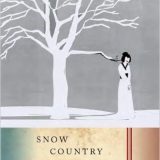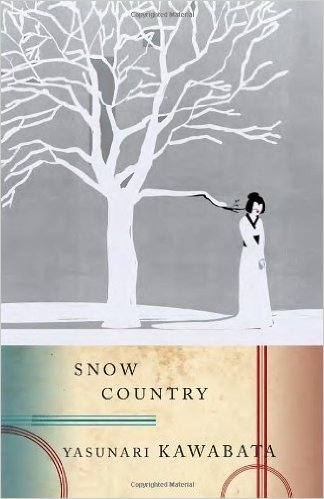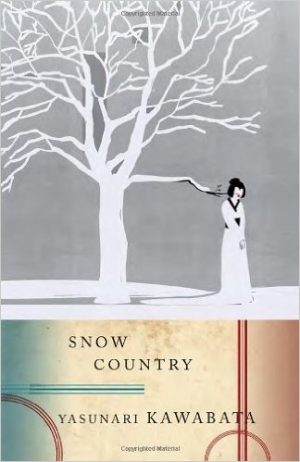Snow Country – Yasunari Kawabata – 1935
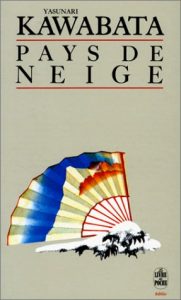
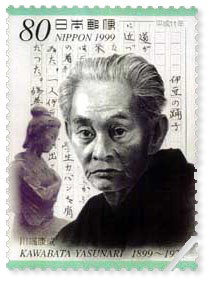
Posted by Ladypurple on 29/12/2005, 4:48:29
Hi all,
In preparation for the discussion of Snow Country, here is the link to an interesting website on Kawabata and Snow Country.
www.sonic.net/~tabine/SAABasho_etc_Spring_2005/kawabata_folder/SAASpring2005_Kawabata_03.html
I hope the link works, I tried it a couple of times. If not, and for more information try www.sonic.net and search for his name in the site.
Friederike
~
Posted by Andrew S on 1/1/2006, 16:12:25
Friederike, your info on Snow Country told me a bunch of things I never knew. I had never been a fan of Kawabata, but regardless, I will join in this reading and discussion once it begins.
I know Yuzawa Onsen (Hot Spring) – I proposed to my then future ex-wife there!
Andrew
~
Posted by Lale on 1/1/2006, 13:17:27 – Snow Country – Kotatsu
While reading the book, I was often puzzled as to the use and the shape of the kotatsu:
“She put her hands in the kotatsu.”
“We played in the kotatsu.”
“I fell asleep in the kotatsu.”
Of course I had heard about the hole dug up under the tables but I had no idea it was heated and that it was called “kotatsu”. A little research revealed many explanations, pictures and this article on Japanese architecture/heating:
The cold and the kotatsu, by BILL STONEHILL:
Chimneys and fireplaces were unknown in traditional houses. Such heating as there was came either from individual hibachi, which threw out about as much heat as the average ashtray, or via kotatsu. The kotatsu was a hole dug in the floor into which you could put your feet. Over this went a short-legged table, and over the table went a very heavy, broad coverlet that extended about a meter on all sides from the table. Over this coverlet, another table top was laid, and a small fire was kept going in the pit with smokeless charcoal. The kotatsu table was used as the dinner table and work table throughout the whole winter.
You sat with your feet in the pit, covered up to your waist with the coverlet, and at least from the waist down you were fairly warm. Of course from the waist on up, you were freezing, so you just piled on more and more layers of clothes. As a matter of fact, if you were a court lady, you piled on exactly 16 layers. Voila! The layered look!
You can read the whole article at: http://www.davidappleyard.com/japan/jp10.htm
Lale

From the waist down you are warm – Kotatsu
~
Posted by Lale on 1/1/2006, 13:19:56 – More on kotatsu
From http://www.japanese-interiors.com/kotatsu.htm:
This small heater is at times, the sociological center of the Japanese family. A typical Japanese New Year’s Eve, for example, goes something like this: all members of a family warm themselves with their legs under the kotatsu, sitting on zabuton cushions, eating mikan (mandarin), watching a singing contest called Kohaku Uta Gassen.
Structurally, a kotatsu is a low, open wooden frame covered by a blanket, upon which a table top sits. Underneath is a heat source, often built into the table itself. Put your legs under the table and wrap the blanet about your waist a bit, and you’ll stay toasty warm.
The first electric kotatsu heater was developed in 1929 by Matushita Electric. Kotatsu are commonly found in homes and restaurants. The kotatsu table is probably the most extensively used piece of furniture in Japan. It is considered the emotional center of the home, around which family and friends gather. Its analogous to the sofa set in the living room of the typical American house.

Kotatsu is a low, open wooden frame covered by a blanket, upon which a table top sits. Underneath is a heat source.
~
Posted by Lale on 1/1/2006, 13:27:17
From http://www.sushicam.com/Journal%20entries/001230.php:
Even though I am able to see my breath in the mornings (yes, it is that cold in the house each winter morning) once I am under the toasty warm kotatsu I do not really notice how cold it is. Before I had a kotatsu it was almost painful to shovel down a quick breakfast in a room just a few degrees above freezing. But now I can sit back and relax because I now have a secret weapon against the notoriously non-insulated Japanese house.
Kotatsu, it’s not just a piece of furniture, it’s a life saver!
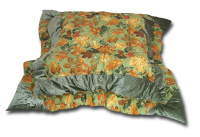
Kotatsu – A secret weapon against the poorly insulated Japanese house.
@
Posted by Andrew S on 1/1/2006, 14:42:06
Lale-cim is correct in her description of kotatsu (no plural in Japanese except for annoying businessmen chain-smoking where it isn’t allowed) Sofa is a great analogy, except that kotatsu being square or rectangular, someone always ends up with their back to the TV.
Surprisingly, kotatsu have a better safety record than most of the warmers we westerners us. Even more surprisingly when you consider that the first Kotatsu were conceived as a way for people to keep on drinking sake in the coldest weather.
They remain a standard piece of furniture in most homes from three-gostarbeiter-studios to big western-style mansions (where the Kotatsu is keep in the family-only wing).
One either wraps a padded blanket around the exposed upper portions of your body, wears a special padded waistcoat, or keeps up such a flow of sake that the cold was a few steps behind.
I’ve never been to a restaurant which had kotatsu. The article may be referring to something else. It would certainly have to be a very old style place (if not actually ancient…) Or, like falling into a black hole, may simply be one of those many events in life still outside my personal experience.
Andrew
~
Posted by Lale on 1/1/2006, 13:36:10 – Geisha – White powder
I don’t really get the powder business. Why would men be attracted to women with a thick layer of white powder on their faces?
http://www.japaneselifestyle.com.au/culture/geisha.html
Lale
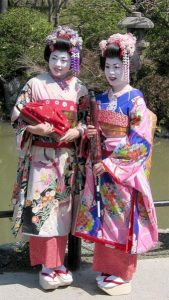
Geisha Maiko Kyoto
~
Posted by Andrew S on 1/1/2006, 15:53:13
It’s cocaine, Lale. Now you understand all this fuss between Japan and Peru regarding Fujimori.
At risk of trying to pass myself off as some sort of Japan expert (impossible) I will tell you what I know.
Geisha are absolutely not prostitutes. Their training and skills are almost exclusively traditional Japanese arts such as singing, dancing, tea service, etc. They are paid for entertaining, either a single client or a group. Within the realm of entertainment might include discussing whether the crown prince’s wife is mentally ill, who was a greater Admiral Togo or Yamamoto, singing (and encouraging customers to sing along)silly, patriotic or otherwise songs.
These days a geisha might work alone or belong to a troupe (the advantage being that often more than one Geisha is required) They usually do not have a direct connection to the teahouse where the guest is being entertained. Nowadays, I suppose a geisha might find herself entertaining in a hotel or private home, but traditionally it was done at teahouses (why ‘teahouse’ I don’t know, it’s the English translation of a word that has stuck).
Which came first, the chicken or the egg? In Japan, as in most of Asia light colored skin conveys ‘High Class’. So, conceivably, the unnatural white is a symbolic high class marker. More likely, the white contrasts or interacts with the other colors and shapes on a geisha’s face.
If you know any Japanese, try this test. Tell them to say the opposite of the word you say. Do it fast so they don’t really have time to think:
Tall – short
Fat – thin
Fast – slow
White – ………
Chances are they will say RED.
A geisha’s lips are colored with a red to match the other circumstances. But wearing whiteface, she could never use any other lipstick color.
Also, the collar at the back of the kimono is carefully formulated (and it stays that way!) in a sort of upside down triangle. Towards the end the white powder sort of tails off, until just skin is exposed. Admiral Yamamoto, a connoisseur of geisha described this as the way to tell a great geisha from a merely good one. OK, we’ll have to take his word for it. But it is true that in literature at least (I’ve met geisha but never beyond, ‘oh you speak such good Japanese) men are supposedly entranced by the neck and transition from white to skin. Sort of in the same way as ‘Lotus Feet’ (tiny bound feet) were supposed to excite tradtional wealthy Chinese to fever pitch.
One interesting, and true geisha story about Yamamoto. Geisha performed lots of little services such as cutting fingernails etc. He lost two fingers fighting the Russsians at the Battle of Tsushima. Since geisha charged 10 sen per finger, they nicknamed him ‘The 80-sen Admiral’.
Andrew
~
Posted by Ladypurple on 2/1/2006, 6:30:02
Hi Lale,
What can one say about fashion styles??? The connection to the artists’ world of performers was very strong. Performers in many cultures used heavy make-up to distinguish them from “ordinary” people.
I read somewhere that originally, geisha were men, but could not see that confirmed.
Here is a reference to an interesting article about the Geisha make-up and its origins.
http://www.immortalgeisha.com/makeup_01.php
Friederike
~
Posted by Lale on 2/1/2006, 12:29:27
: Here is a reference to an interesting article about
: the Geisha make-up and its origins.
:
: http://www.immortalgeisha.com/makeup_01.php
Thank you Friederike. This article was very enlightening. One thing surprised me greatly:
To finish off this dramatic look, they would then blacken their teeth. This was achieved by staining the teeth with a mixture of oxidized iron filings steeped in an acidic solution. Application of this mixture would need to be repeated every couple of days or the teeth would return to white.
Thank goodness they don’t do this anymore.
Lale
~
Posted by Steven on 3/1/2006, 13:20:47
: To finish off this dramatic look, they would then
: blacken their teeth.
This brings to mind the comparison of Komako’s lips to “a beautiful little circle of leeches.” With the teeth blacked you can understand the metaphor even better. I took it as having a double meaning – beautiful but sinister – but that may not have been Kawabata’s intention. Someone whose culture found black teeth beautiful might also see honest beauty in a leech.
~
Posted by Andrew S on 4/1/2006, 0:49:49
They very well may have been. Traditional Kabuki features an Onnagata – a man playing a woman’s role.
~
Posted by Lale on 1/1/2006, 14:00:45 – Mountain Trousers
I am dying to see an image of “mountain trousers pulled over a kimono” but I could not find any pictures on the net. Maybe those of you with better “googling” skills can find us a picture. Or maybe our Andrew who is familiar with Japanese culture can give us an idea, he was once (when he was young and beautiful) married to a Japanese girl (who was also young and beautiful).
Andrew, I hope your ex won’t sue us for using her wedding photo without permission.
Lale
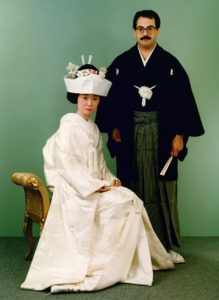
Andrew’s Wedding Photo – Japanese Wedding
~
Posted by Andrew S on 1/1/2006, 16:07:03
I’ll have to look into this mountain trousers thing.
It might be hard to see in the photo, but I am actually wearing trousers. A ‘split skirt’ might be a better description. They are called ‘Hakama’ and were traditional for activities such as horseback riding, invading your neighbor’s castle, actually, I can’t really tell you what and when, except that nowadays they are de rigueur for any traditional activity such as getting married.
Snow country people developed reed/straw overcoats and pants/skirts that were worn over their clothes in the rain as well as snow. When I saw pictures of ‘Oetzi’ the mummified gentleman found ten years ago in the alps, I was struck by the similarity of the straw coverings. The Japanese coverage of Oetzi minimized this similarity. Hmmmm……
Andrew
~
Posted by Ladypurple on 1/1/2006, 20:08:06
Good research effort there, Lale! I did not find anything specific either – however, it seems from some of the references that the “mountain trousers” were a kind of Hamaka trousers. They were tied at the ankle. Hamaka trousers are worn over the kimono. It might make it all look pretty bulky… Wone’s hamaka trousers are a bit different from the men’s – still the pleats have to be there, given their important symbolism.
Friederike
~
Posted by Steven on 1/1/2006, 20:45:04
Lale discovered that Sweden had issued a stamp in 1985 honoring Kawabata for his 1968 Nobel Prize. I found it for sale by a dealer in Madrid and added it to our online collection. Other stamps in the set, also now in our gallery, honor William Faulkner, Halidor Laxness, Miguel Asturias and Patrick White.
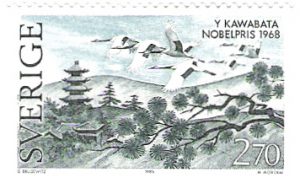
1985 Stamp – Honoring Kawabata – 1968 Nobel Prize – Nobelpris
~
Posted by Ladypurple on 2/1/2006, 6:03:42
Wonderful! Thank you Steven.
It almost could be an image of the Mountain range in Snow Country…
Friederike
~
Posted by Ladypurple on 4/1/2006, 5:07:58 – Kawabata and Haiku
“In the spring, cherry blossoms, in the summer the cuckoo. In autumn the moon, and in winter the snow, clear, cold.”
“The winter moon comes from the clouds to keep me company. The wind is piercing, the snow is cold.”
The first of these poems is by the priest Dogen (1200-1253) and bears the title “Innate Spirit”. The second is by the priest Myoe (1173-1232).
“When I am asked for specimens of calligraphy, it is these poems that I often choose.” (From Kawabata’s Nobel Lecture)
Kawabata’s work is often compared to Haiku – Haiku in prose. I thought it useful to go back to K.’s Nobel Lecture to get a sense of his own reflections on the topic.
In case you’ve missed it, here is the link:
http://nobelprize.org/literature/laureates/1968/kawabata-lecture-e.html
Friederike
~
Posted by Rizwan on 4/1/2006, 12:27:09
Thank you for the link, Friederike. Very interesting article, and great site in general.
In Kawabata’s acceptance speech, what really caught my eye was his frank and resolute opposition to suicide. In fact, it’s interesting that he even brought the subject up–doubly so knowing that he committed suicide just 4 years later.
@~
Posted by Lale on 4/1/2006, 13:38:41
Gosh, I first thought that this was his acceptance speech, I was wondering how long it must have taken him to deliver this speech, the length is not very haiku-like.
Then I found the acceptance speech, which is short and sweet. (http://nobelprize.org/literature/laureates/1968/kawabata-speech.html)
The long one is a lecture, it is not clear where he gave that.
Lale
~
Posted by Ladypurple on 4/1/2006, 14:30:09
The lecture is separate – all laureates give one I think earlier the same day.
I thought that Kawabata’s said a lot about his approach to literature…
Friederike
~
Posted by Rizwan on 4/1/2006, 15:21:49
Ah, good point, Lale’cim. Sorry for the mix-up.
~
Posted by Ladypurple on 7/1/2006, 17:02:41 – Chijimi
More background and context is probably needed for most of us. Here is some information that I found after consistent googling…
Ojiya Ramie Crepe
Legacy of the snow country and skilled hands
Using shiny ramie thread, Ojiya Chijimi ramie crepe, which developed as an offshoot of Echigo Jofu ramie, is one of the finest summer fabrics ever made, with its crepe-like texture that does not stick to the skin.
The source is an interview with an expert weaver…
http://www.kougei.or.jp/english/crafts/0110/d0110-5.html
I understand that the earlier version of Snow Country, published in 1937 did not have the Chijimi excursion in the text. Does it symbolize a change in K’s intention for the novel? The later inserted text is based on a separate short story published in 1940 “Fire in the Snow”.
Friederike
~
Posted by Ladypurple on 7/1/2006, 17:11:41
I was reading some study on Kawabata – given my ignorance of Japanese literature it seemed useful (and it was – but this is for later on) – but I also found this site that might come in handy
:
Glossary of Japanese Art Terms
http://www.michionline.org/resources/Glossary/
F
~
Posted by Lale on 8/1/2006, 14:41:04
: I understand that the earlier version of Snow Country,
: published in 1937 did not have the Chijimi excursion
: in the text. Does it symbolize a change in K’s
: intention for the novel?
That chapter seemed like a different book. I immediately noticed the difference (in time, in style, in intent). Up until that point there wasn’t a page when Komako or Yoko weren’t mentioned. Then, when he starts with the chijimi (page 150), I felt Komako or Yoko were never going to come back again. It was like the author had switched interests all of a sudden. The fluidity of the story was broken.
Afterwards, when I read the introduction, I learned that the book was written in bits and pieces over the years and that more than a decade had passed between the writing of the beginning and the writing of the end.
Lale
~
Posted by Ladypurple on 8/1/2006, 15:24:02
I’m glad you had the same feeling! Everything else flows in a very similar vein… wonder how he had ended the story before inserting the excursion. Maybe the fire was there anyway?
Interestingly enough, some researcher suggested that Kawabata inserted the Chijimi element to fall in line with contemporary Japanese politics – Shimamura suddenly talks about motherhood – he envisages Komako as the mother of somebody else’s child. I think this might be a bit far fetched, still something to consider.
The other interesting context information I came across is the Japanese (originally Chinese) mythology of the weaver princess and the cow herder and the Milky Way. Did you know that? It the basis for the annual festival of Tanabata festival – the seventh day of the seventh month.
There are numerous references to the Milky Way, aren’t there – anyway the stars – and at the end the “Milky flowed down into him with a roar.”
Friederike
~
Posted by Ladypurple on 8/1/2006, 11:38:32 – Today’s Japan
It seems unusual snowfall is covering areas of Japan…
Snow came early and seems to break records.
http://news.bbc.co.uk/2/hi/in_pictures/4592056.stm
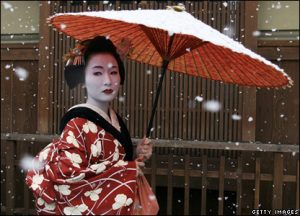
Geisha in Snow
~
Posted by Lale on 8/1/2006, 14:30:43
: http://news.bbc.co.uk/2/hi/in_pictures/4592056.stm
Oh, wow, some of these photos are amazing. We never have that much snow on our rooftops. Maybe we should move to Japan, Friederike, we are not getting enough snow here. Darn, you think you found a nice place, then you see there are better places to live.
Lale
~
Posted by Andrew S on 9/1/2006, 22:07:15
The photos don’t do justice to the phenomenal amounts of snow that area gets. Hokkaido, much further north, gets less snow. The climate, geography, and cold moisture coming off the sea create accumulations of snow that can be mind-boggling.
Andrew
~
Posted by Ladypurple on 8/1/2006, 15:27:58
Hi all,
Should we start with first reactions to Snow Country? What did you like about it most, what least? Would you want to read more of Kawabata’s books? Why or why not?
Does the story live outside its context of Japan in the late thirties/early forties?
And more
Friederike
~
Posted by Steven on 8/1/2006, 20:50:09
I enjoyed reading Snow Country, although I’m not sure I got from it everything I could or should have.
The poetic language, the exotic setting, the sometimes startling frankness, and the introduction to a different culture were all things I liked about the novel. I definitely would like to read more of Kawabata’s work.
The lack of continuity (which has been well explained in one of your other postings) was perhaps the most negative aspect. I also found it annoying that the translator or editor always put “mountain trousers” in quotes; it disturbs the flow of the text to no purpose.
As to whether the story would work outside its setting – yes, the theme could be applied almost anywhere, but the setting is a large part of the novel’s attraction, so it would probably be a weaker work in a more commonplace locale.
The part of the novel I didn’t fully grasp was Yoko – her relationship to Komako and Shimamura’s feelings toward her at the fire: “The years and months with Komako seemed to be lighted up in that instant; and there, he knew, was the anguish.” Is it simply that Shimamura realizes he is more taken with Yoko than with Komako, and regrets the lost opportunity? Or is it something more profound?
Steven
~
Posted by Lale on 9/1/2006, 14:11:12
I enjoyed learning new things about Japanese culture.
The story, however, didn’t speak to me, or I wasn’t listening carefully enough. The dialogues frustrated me. I wasn’t sure if this was the way Japanese people spoke amongst themselves or if it was just the author’s style. Or if something was lost in the translation…
It was hard to understand what made Shimamura fell for Komako, what exactly was the attraction? Then the whole business with Yoko was a mystery. Like Steven, I also didn’t fully grasp the relationships between Yoko & Shimamura and Yoko & Komako. I did get the sense that Shimamura was more fascinated by Yoko. But we really didn’t get to know Yoko. For that matter, we didn’t get to know Shimamura either. The only person who was sufficiently revealed to us was Komako and even in that case, she didn’t seem like a person with whom a young, presumably handsome, rich Tokyo guy would fall for.
So, all in all, I really didn’t get this book. I don’t know if we were supposed to understand all the dynamics between Shimamura, Komako, Yoko and the music teacher’s son but it would have been nice to understand some things. The introduction calls this “complicated human relationships” and I am fine with relationships being complicated (they always are) but in a story like this I would have liked to know the characters a little better to understand their feelings.
Komako was jealous of Yoko and she was afraid that Shimamura would prefer Yoko to her. I think the only thing that was made clear to me was Komako’s jealousy. But the rest …
Lale
~
Posted by Ladypurple on 10/1/2006, 14:46:35
So here goes… first impressions
The overall opinion of Snow Country from my perspective is “intriguing”. I felt I had to blank my mind of other literature and just go with the flow here. Having read a bit about haiku, I was following the text very slowly, looking for images and symbols: unusual juxtaposition of objects or descriptors, contracts in emotions evoked by colour and temperature. “Cold” was evidently something positive for Shimimura; also he comments often of “emptiness” as something positive. It was difficult sometimes to sense what feelings Kawabata wanted to convey to the reader. Some comment I read suggested that emptiness is an important concept in Zen Buddhism. I don’t know very much about it. This may all be much clearer for the Japanese reader.
The close connection to nature is clearly of importance to Shimimura and Kawabata himself. When the protagonists are outside in a beautiful nature setting, dialogue dies. A couple of times it is stated that Shimimura and Komako have nothing to say to each other when alone in nature. At the end it is nature that wins represented by the Milky Way.
The contrast between the two main protagonists could not be more pronounced: we have the chatty, emotional girl-child geisha who has nothing much to show for herself than the parties she goes to. Although there is reference to reading books and recording her reactions in her diary but one wonders how serious this is. Also, another hint of her decadent (?) lifestyle is her drunkenness. In fact, she probably doesn’t behave like a geisha should when she is with Shimimura. In contrast, the little we know of Shimimura is not very attractive either. He is middle aged, round and short and does probably not attract pretty women except for his money. We don’t get the sense that he is particularly generous. He is bored and mildly amused by Komako. He doesn’t seem to know or to reflect how he is attracted to her. Yoko, I think, is an “ideal” beauty; serious, “pure” and unreachable, and therefore desirable to Shimimura in a spiritual sense. The relationship between Komako and Yoko is almost like that of rivaling siblings. They are very close and Komako feels responsible as the older, at the same time they have been competing for favours and lovers with Yoko winning.
Finally, I found the innuendo, half expressions and such somewhat frustrating. It always seemed to me that I was missing something and was reluctant to interpret what the text could mean. Maybe one was supposed to do that though.
As I said at the beginning, intriguing and lingering in your mind despite yourself. I think I would read something else by Kawabata to get, maybe, a better understanding.
Friederike
~
Posted by Steven on 10/1/2006, 15:46:17
Good observations, with a lot of points I missed.
: The contrast between the two main protagonists could
: not be more pronounced:
One thing we can say about Shimimura is that he isn’t interested in reality. He likes to study ballet, but doesn’t bother to see one. He prefers to look at Yoko’s reflection in the window rather than Yoko herself, and, of course, he prefers a geisha – an artificial beauty.
Komako, on the other hand, longs to abandon her artificial persona for reality. She wants out of the geisha life, and is always breaking the rules to (figuratively) let her hair down in front of Shimamura. Their relationship is doomed because she wants to be the very thing he doesn’t desire, a real person.
~
Posted by Lale on 10/1/2006, 16:15:57
After reading Steven and Friederike’s comments I understand the book better. Thank you.
: He likes to study ballet, but doesn’t bother to see one.
I thought this was very stupid, and made me dislike Shimamura intensely. I wasn’t able to pinpoint the reason as “not being interested in reality”, I thought he was just lazy. But now I think maybe, to a certain degree, they are the same thing.
Why do you think Shimamura did not consider opening a restaurant for Komako?
Lale
~
Posted by Lale on 10/1/2006, 16:25:54
One other example of the lack of fluidity in the story:
At the beginning, when Shimamura is returning to the hot spring, in the train, he makes a fist and wiggles the one finger that has touched Komako. When he sees her, he says, referring to the finger, “this missed you the most”. We are shown a Shimamura who is thinking about Komako (back then, he didn’t even know her name, she was “the woman”), missing her, longing, yearning.
Later on, that Shimamura dissappears. He and his feelings are less and less present. The Shimamura, lazy and indifferent, doesn’t seem like the same guy who would look at his fist and reminisce.
I understand that the novely wore off and Yoko entered the picture, Komako became less and less attractive (what with the drunkennessand all), but no reason for Shimamura to dissappear as a feeling, wanting human being.
Lale
~
Posted by Ladypurple on 11/1/2006, 8:22:25
If you pursue Steven’s point about Sh being attracted to everything that is not real, you can also argue that initially she was not “real”, his finger remembered her most – as he spent more time with her, she became too real in a way and that distanced him from her – whereas Yoko remained remote from his personal reality. I don’t think Shimamura expressed any feelings except for the visual. I’m not sure whether it is the issue of the “novelty wearing off” and rather that she became too close and real, comparable to his Tokyo (real) life.
Friederike
~
Posted by Ladypurple on 10/1/2006, 16:59:33
Lack of interest in reality on Shimamura’s side while Komako wants to be more than she can be. Absolutely correct! and well put, Steven. It reminded me also of the early passage when Shimamura wants to be “friends” with Komako – again a rather unnrealistic wish as is shown shortly thereafter…
Friederike
~
Posted by Steven on 11/1/2006, 11:37:00
We’ve discussed Shimamura, but I wanted also to go back to what Friederike said about Komako:
: we have the chatty, emotional girl-child geisha who has nothing much to show for
: herself than the parties she goes to. Although there
: is reference to reading books and recording her
: reactions in her diary but one wonders how serious
: this is. Also, another hint of her decadent (?)
: lifestyle is her drunkenness. In fact, she probably
: doesn’t behave like a geisha should when she is with Shimimura.
Given this shallowness, why would she attach herself to a middle-aged cheapskate who offers her no future whatsoever? Two visits a year is hardly enough to sustain a romance at her age, especially when she has so many other clients to choose from. But, towards the end, she is the one following Shimamura around and getting jealous of his interest in Yoko. Is it because he is someone “safe,” in front of whom she doesn’t have to be proper? Is he a surrogate father as well as lover? Could this be why she reacts so negatively when he calls her a “good woman” instead of a “good girl”?
~
Posted by Ladypurple on 11/1/2006, 16:05:05
That is a very good question! I have been wondering… Remember, though, in the beginning there is quite a bit of talk about her not being a “real” geisha. She did get into it to help pay the bills. Maybe she continues to feel that way – she really doesn’t want to be one and rather be a “normal” girl. So she “plays” at being a “girlfriend” – a term that probably doesn’t exit in the Japanese context… Why attach herself to Shimamura? I cannot figure this out! She speaks several times of the time afterwards and what she can do to settle down so to say.
Anybody else?
Friederike
~
Posted by LadyPurple on 18/1/2006, 15:52:41
Hi everybody,
Rizwan, have you finished with Snow Country? Do you want to kick off a second round of conversation on the book?
I am hoping that others can also chip in with more thoughts and reactions. I for one am wondering how much we are missing by not reading the novel in Japanese. The translation to me, and to others here it seems, comes across as somewhat strange and at times irritatingly unrefined. But it could be very different for the Japanese reader who has the benefit not only of language but also of connotations.
Friederike
~
Posted by Rizwan on 18/1/2006, 17:03:36
Sorry I’m so lame. I have about 70 pages left. I’m taking a flight out to the west coast tonight, so I’ll surely finish on the plane. I’ll try to post my comments from out there, but at the latest, I’ll have them posted on Monday. Feel free to get started without me!
Just quickly: regarding what you asked, did you all read the Siedensteker (sp?) trans? I agree, the style is striking, but I’m not sure it’s the translation. Reading the book, I’m reminded of some of the film dialogue in Ozu’s classic “Tokyo Story.” (unless he also translated the subtitles!) I don’t doubt, though, that a lot has gone over my head, stuff that would be more easily caught by someone immersed in Japanese culture.
~
Posted by Lale on 18/1/2006, 17:18:07
: Just quickly: regarding what you asked, did you all
: read the Siedensteker (sp?) trans? I agree, the style
Mine is also Seidensticker.
L.
~
Posted by Rizwan on 18/1/2006, 17:06:43
Another very quick thought: I was sure I could just plow through the book in no time. I tried to do just that, in fact, and found that I didn’t understand a thing! It’s very good so far, but it’s such a different style from Proust, whom I’m currently in the middle of. As you all know, Proust has page-long sentences sometimes, and goes into all sorts of introspective detail. Kawabata, on the other hand, his style is often (and accurately) compared to a haiku poem, as some here have pointed out. Lots of symbolism, lots of subtleties and suggestions and reading between the lines, no overt introspection whatsoever (if that makes any sense). And where a single evening’s episode in Proust can go on for hundreds of pages, months can go by on a single page of Kawabata. I don’t know if I could have chosen a more different book.
~
Posted by Steven on 18/1/2006, 22:52:03
: I am hoping that others can also chip in with more thoughts and reactions. I for one am wondering how
: much we are missing by not reading the novel in Japanese. The translation to me, and to others here
: it seems, comes across as somewhat strange and at times irritatingly unrefined. But it could be very
: different for the Japanese reader who has the benefit not only of language but also of connotations.
Yes, there is much cultural groundwork that we are missing. Too bad there isn’t an “annotated edition.”
Here is one example: The repeated references to the Milky Way in the final pages and especially the last sentence. The first reference I can find, as Komako and Shimimura are rushing to the fire, is:
“‘The Milky Way. Beautiful, isn’t it,’ Komako murmured. She looked up at the sky as she ran off ahead of him.
“The Milky Way. Shimamura too looked up, and he felt himself floating into the Milky Way. Its radiance was so near that it seemed to take him up into it. Was this the bright vastness the poet Basho saw when he wrote of the Milky Way arched over a stormy sea?”
Basho’s haiku is easy to find on the web:
The rough sea –
Extending toward Sado Isle,
The Milky Way.
The meaning, found in a quote on the web from a biography of Basho by Makoto Ueda, is:
“…the concept that one attains perfect spiritual serenity by immersing oneself in the egoless, impersonal life of nature. The complete absorption of one’s petty ego into the vast, powerful, magnificent universe…”
The references to the Milky Way continue through the final chapter of Snow Country:
“And the Milky Way, like a great aurora, flowed through his body to stand at the edges of the earth.”
Along with the Milky Way references, there are also warnings from Komako that Shimamura may lose his footing and, just before he sees the Milky Way there is this portentous paragraph:
“There was indeed no reason for him to go on. His excitement fell away. He looked down at his feet and saw that they had come to the crossing.”
Shimamura wants to wait, but Komako calls him on.
Finally the closing sentence brings together the references to Shimamura’s feet and the Milky Way:
“As he caught his footing, his head fell back, and the Milky Way flowed down inside him with a roar.”
Faced with Yoko’s tragedy and Komako’s anguish, Shimamura suddenly understands and accepts his own insignifigance and superficiality.
There are many other references that are undoubtedly important, but not as easy to understand as the Milky Way. For example, in that same sequence of events:
“She threw herself against him. He reeled back a step or two. A row of onions was growing in the thin snow beside the road.”
Is this a reference to another Basho haiku:
After morning snow
onion shoots rise in the garden
like little signposts.
~
Posted by LadyPurple on 19/1/2006, 21:09:07
Milky Way – you may have missed my earlier comment (8.1.) in the Chijimi thread about that – I repeat it here.
The other interesting context information I came across is the Japanese (originally Chinese) mythology of the weaver princess and the cow herder and the Milky Way. Did you know that? It the basis for the annual festival of Tanabata festival – the seventh day of the seventh month.
There are numerous references to the Milky Way, aren’t there – anyway the stars – and at the end the “Milky flowed down into him with a roar.”
In addition to the haiku reference, it seems that the story of the Milky Way was very popular and common knowledge. The interesting link also with Shimamura’s visit to the weaver maidens…
Friederike
~
Posted by Lale on 29/1/2006, 13:49:16
I was happy to read something from Japan and I enjoyed thoroughly the exposure to the Japanese culture and learning all about chijimi and kotatsu and hot springs and such. However, I didn’t really warm up to the book, the story or the characters. I felt I was not “getting” it. This proved to be true once I read Friederike and Steven’s comments. Obviously I had missed a lot of the meaning and I had failed in proper interpretation. So, all in all, I am happy to have read it but at the end, it didn’t rate very highly in my opinion. I would give it 3 stars.
Lale
~
Posted by Steven on 30/1/2006, 8:37:17
My evaluation is exactly the same as Lale’s. I would give it a parenthetical three stars, signifying the reader’s limitations more than the author’s. Snow Country is clearly a work that requires some familiarity with Japanese poetic tradition to appreciate fully the cultural associations that accompany the elements of the story. Without that background, it is a work of beautiful settings peopled by enigmatic characters and sewn loosely together by a sketchy plot.
Thanks to its modest length, I would still recommend Snow Country to those who would like a taste of the poetic quality of Kawabata’s writing, knowing that much of the novel’s meaning lies out of reach.
As a more approachable introduction to Japanese literature, I highly recommend The Makioka Sisters by Junichiro Tanizaki, a book I happen to have finished just yesterday. It is the story of four sisters of a prominent but declining Osaka family in the years just prior to the Second World War. One of the themes is the impact of encroaching Western culture on Japanese society, thereby providing an excellent primer on the nature of that society. Tanizaki’s style also contrasts sharply with that of Kawabata and other modern Japanese authors. The Makioka Sisters is a lengthy, leisurely paced, gentle and comfortable work reminiscent of a Victorian novel.
~
Posted by Rizwan on 30/1/2006, 14:54:43
Hi all,
Sorry to post my thoughts so late. I finally finished the book early last week, but found myself puzzled over what to say about it. I still am. I’m not even sure if I really liked the book. Interesting and thought-provoking are probably more accurate, but don’t take that to mean I fully understood it.
Superficially, the alpine setting reminded me of Mann’s “Magic Mountain” –p. 14: “He wondered whether the flowing landscape was not symbolic of the passage of time.” But even on a deeper level, there is a similarity that is just as profound, if much more subtle and elusive, as in MM. I’m talking about the evolution of Shimamura’s knowledge about himself. We know that in the beginning, he is merely a poseur, a master of the ballet, for example, whose knowledge of the ballet is derived entirely from books (It’s scary to think, but I wonder if I myself am not like this sometimes regarding other things). This fact speaks directly to Shimamura’s selfish and self-centered personality in general: he cultivates no relationships beyond the superficial; he has little understanding of either himself or other people; he risks nothing and gains nothing as a result; he merely goes through the motions of life, flitting about like a fly from point to point. At his core, he is a lonely man, his affected actions merely masking the intensity of this loneliness.
Enter Komako. His encounters with her provide seemingly the first meaningful connection he’s made with anyone. Not that it’s easy going or destined to last, but it’s definitely there. Take, for example, his thoughts on page 154-5 in my edition. Even as he acknowledges that “this love (with Komako) would leave behind it nothing as definite as a piece of Chimiji,” the “image of Komako as the mother of another man’s children” shocks him into a moment of self-recognition, leaving him “gazing at his own coldness” towards her. “All of Komako came to him, but it seemed nothing went out from him to her. He heard in his chest, like snow piling up, the sound of Komako, an echo beating against empty walls. And he knew that he could not go on pampering (and fooling) himself forever.”
Aside from that (and I’m not sure I even got that right!), like the rest of you, I had trouble making heads or tails of this book. I never really understood the whole Yoko thing, unless she was some kind of self-inflicted obstacle preventing Shimamura from having to return Komako’s love. Other than that, her presence in the book, and Shimamura’s fascination with her, puzzled me.
Regarding the setting: it might be obvious, but to me, the bleakness of the setting stood for the loneliness, unhappiness, and inevitable despair of each of the characters. This is where the snowy mountain setting differs from that in MM. In both books, the setting plays a major role, but I never thought of it as bleak in MM. Here I do. I wonder if there is some religious, Buddhist symbolism at work here.
2.5 stars
~
Posted by LadyPurple on 31/1/2006, 6:24:04
Hi all,
I was interested in reading your overall take on Snow Country. Mine, it seems, is somewhat different.
Stars: I gave it 4.5 stars in my amazon review. The -.5 is for the translation that might have been better in conveying Kawabata to the English language reader.
Reaction: The fact that the novel is “strange” and Japanese literature not easily accessible for us, didn’t take away from its quality for me. I knew that before I started. Also, the fact that we cannot readily relate to the characters for me is immaterial. Once I accepted to read a Japanese novel from that particular period, I accepted that I had to work at understanding what it all meant. As a portray of Japanese culture at the time, I think it is brilliant in its economy of language, in its evocation of moods and description of human contradictions and its painting of landscape.
Context: I read around the book to get a better understanding of that culture and the symbolism. While I know very little about Zen Buddhism, it is nevertheless a strong component in the novel. Reading Snow Country was “a project” for me and I am glad I took the time for it.
Friederike
~
Posted by Rizwan on 31/1/2006, 11:59:17
Hi Friederike,
I appreciate your comments on the book. And I agree with you on two important points: 1. relating to the characters is immaterial to its worth as a work of art; and 2. despite its small size, this book requires a good deal of effort.
Regarding this last point: I don’t consider this a bad thing. Any work of art that readily presents all there is to discover about it at first glance is not much of a work of art at all. The best books, I’ve found, are the ones that require extra effort to uncover a fuller appreciation of what they have to offer.
That said: I don’t blame my lack of understanding of certain aspects of the book (especially involving Yoko) on Kawabata at all. The failure is all mine, I fully admit. I should have added to my original comments that, despite my somewhat negative first impression, “Snow Country” is a book I need to return to in order to give it a fair chance. There is a reason this man won the Nobel Prize and wrote books that so many hold in high esteem. The onus is on me to discover what that reason is. Perhaps another Kawabata novel is in order? I’ve got two more of his at home: “The Master of Go,” and “Beauty & Sadness,” the latter of which I’ve heard great things about.
Rizwan
~
Posted by LadyPurple on 31/1/2006, 16:41:17
Hi Rizwan,
And I appreciate your response. It is a fine line between assessing a book on the basis one one’s own reaction to and understanding of it and critiquing it on the basis of “literary value” whatever that means. Kawabata poses some challenges in this regard. It would have been helpful to have an “annotated” version in English. As one can find with some classic novels. Without doubt the Japanese world of the thirties is not an environment we know much about – maybe even young Japanese would need assistance in understanding the text. Who knows. I started re-reading it for the amazon review and will certainly dig more into it at a later stage.
Friederike
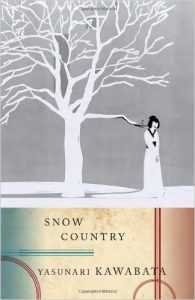
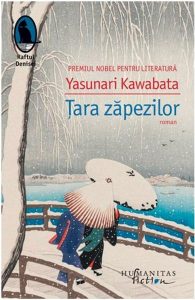 Romanian edition.
Romanian edition.


